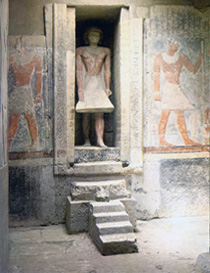 1
1Indexical and Symbolic Entrances
The thesis that underpins Picard's proposition, as outlined in the previous chapter, is perfectly encapsulated within the archaeological term the false-door, originally coined to describe painted or bas-relief faux doors found in the interiors and on the exteriors of ancient tombs (Picard 1970:97). The Egyptians were amongst the first to use this motif and the hieroglyphs and iconography that they associated with it identify it as a symbolic entrance to an underworld dwelling place inhabited by the souls of the dead (fig.1-2). According to Picard the faux doors in Second Style Roman wall-painting connote a similar indexical-symbolic meaning associated with tragedy and catharsis: tragedy linked to false-door imagery produced in response to bereavement; and catharsis associated with benign feelings linked to memorialisation and symbolic re-membering (re-constituting the dead in a lasting form). The Etruscan tombs at Tarquinia, North of Rome, contain several examples of an intermediary phase between Egyptian and Roman false-doors. The Tomb of the Augurs is a particularly defining example (fig.3). The door in this tomb is depicted at the back of the chamber, in a manner similar to the painted or bas-relief false-doors found in Egypt, but with the addition of lamenting figures placed either side of the door and funerary motifs on the lateral walls.
In contrast to the Egyptian and Etruscan false-doors, Roman depictions were contextualised by means of highly sophisticated perspectival compositions. In addition to being both illusory entrances and allusions to metaphysical domains, Roman false-doors were experienced physically as well as emotionally. The viewer’s sense of being there is engendered by a sophisticated interplay between real and virtual space. Both seamlessly interact because the viewer is encouraged to look over a wall, or through a gate, in order to physically and emotionally experience the space that lies beyond the wall (fig.4). Once the belief in this virtual world is established the paintings true fetish identity is revealed through its iconic allusions. It is no longer just a pictorial representation of an entrance, but a staged environment in which the protagonists (the household) act out their daily lives, both mundane and ritualised.
The Boscoreale door, in Casa di Fannius Synistor, that Picard identified as a door to a metaphysical world, is one of many found in Roman wall-painting, all of which would have supported his thesis. Had the ancient Aegean tombs at Vergina been discovered he might also have made a very convincing parallel between the Boscoreale door and a tomb believed to be that of Philip II of Macedon (fig.5). Like the Boscoreale door, it too has a chthonic hunting frieze above it, thus further confirming Picard’s observation that this motif was used in a funerial context. Depicting the hunting and slaying of wild boar signified the triumph of immortality over death, for the following reasons. Firstly, the illusive and highly dangerous wild boar is considered to have an evil or demonic appearance, because its face is often caked with mud due to using its snout to search for roots and tubas; and secondly, in Greek mythology they are portrayed as the instrument of death because it was a boar that savaged Adonis - the personification of youthful beauty.
 1
13 False-door, Tomb of the Augurs, Tarquinia, Italy, c.550 BC
4 Villa di Poppea, Oplontis, wall-painting depicting an open gate leading to a sanctuary dedicated to Apollo and family ancestors
5 Tomb associated with Phillip II of Macedon, c.336 BC, Vergina
|